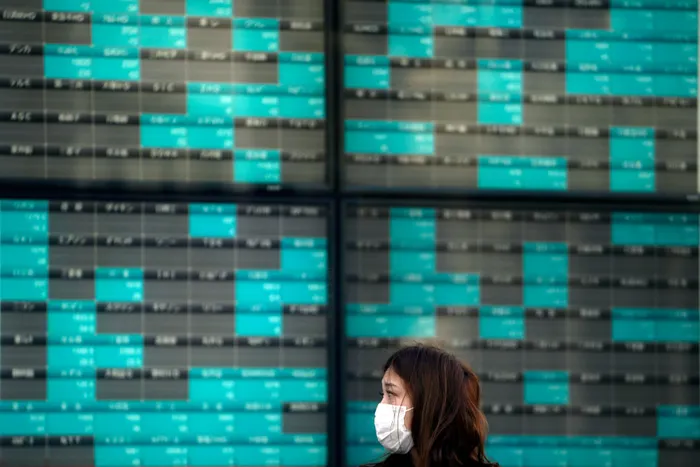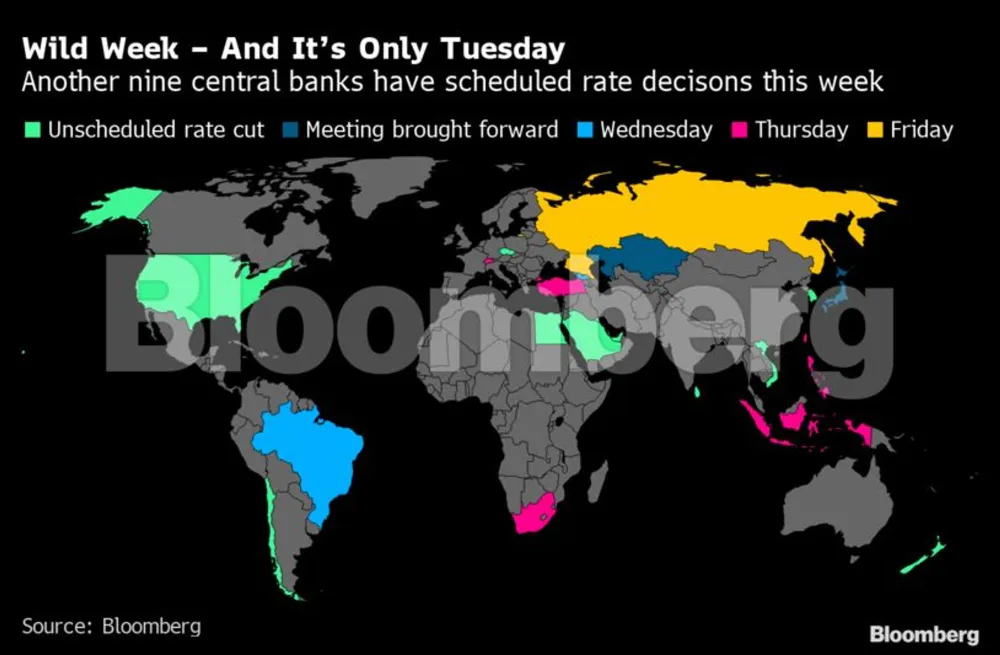Central banks stay on the frontline of global economic fight

In this Thursday, March 12, 2020, photo, a woman stands in front of an electronic stock board showing Japan's Nikkei 225 index at a securities firm in Tokyo. Asian stock markets and U.S. futures fell Monday, March 16, 2020, after the Federal Reserve slashed its key interest rate to shore up economic growth in the face of mounting global anti-virus controls that are shutting down business and travel. (AP Photo/Eugene Hoshiko) In this Thursday, March 12, 2020, photo, a woman stands in front of an electronic stock board showing Japan's Nikkei 225 index at a securities firm in Tokyo. Asian stock markets and U.S. futures fell Monday, March 16, 2020, after the Federal Reserve slashed its key interest rate to shore up economic growth in the face of mounting global anti-virus controls that are shutting down business and travel. (AP Photo/Eugene Hoshiko)
INTERNATIONAL - Central banks are out to prove the doubters wrong, unleashing a whole new wave of stimulus after years of being told they were out of ammunition.
In response to the economic fallout from the coronavirus, there’s been a string of interest-rate cuts, bond purchases, lending support and liquidity measures.
And this week is proving no different, as policy makers try to get ahead of what could be a global recession.
The Federal Reserve brought its meeting forward and cut interest rates for the second time this month, while the Bank of Japan also announced emergency stimulus.
Just since Sunday, a dozen central banks cut interest rates, and that’s before nine scheduled decisions from Wednesday-Friday.

Here’s what central banks the banks with rate decisions on their books may get up to:
Brazil
Wednesday, after 6 p.m. local time in Brasilia
Policy rate currently at 4.25%; predicted to cut to 4%
Already sold dollars from its reserves, auctioned currency swap contracts and offered dollar lines to support the real
No press conference scheduled
Pressure is growing on Brazil’s central bank to ease monetary policy more aggressively, with UBS calling for a full percentage point cut. Just two months ago, policy makers had said they were likely to pause to assess the impact of a record-breaking monetary easing cycle that reduced the benchmark interest rate by 225 basis points.
Russia
Friday, 1:30 p.m. local time in Moscow
Policy rate currently at 6%; predicted to hold
Already cut rates once this year (February)
No press conference scheduled
Pressure is building on the Bank of Russia as the fallout from coronavirus and President Vladimir Putin’s oil-price war with Saudi Arabia sent the ruble plunging. Markets suggest a flip to rate hikes after six straight cuts might be on the horizon. Most economists predict a hold this week though as Governor Elvira Nabiullina assesses how the ruble slump will impact an inflation rate that’s been stuck below target for months.
Turkey
Thursday, 2 p.m. local time in Ankara
Policy rate currently at 10.75%; predicted to cut to 10.25%
Already cut rates twice this year (January, February)
No press conference
Little stands in the way of Turkey’s central bank’s seventh straight interest-rate cut after monetary easing by the world’s largest central banks and a drop in oil prices amid the global coronavirus outbreak. Turkey’s central bank, which has slashed interest rates to 10.75% from 24% last June, will have to be cautious with the size of the cut when it meets this week: the lira is trading at the lowest levels against the dollar since the currency’s 2018 meltdown.
Indonesia
Thursday, 2 p.m. local time in Jakarta
Policy rate currently at 4.75%; majority of economists predict cut to 4.5%
Already bought billions of dollars in government bonds and actively intervening in currency market to stabilize rupiah
With the outlook for growth deteriorating and Covid-19 cases in Indonesia jumping, the central bank is under pressure to mount an aggressive monetary policy response, especially in the wake of similar action elsewhere. While Governor Perry Warjiyo has been making regular comments to highlight market interventions aimed at restoring confidence, some economists are calling for a 50bps cut Thursday. The currency, which has fallen more than 9% against the dollar in the past month amid rampant risk aversion, is a complicating factor.
Switzerland
Thursday, 9:30 a.m. local time in Zurich
Policy rate currently at -0.75%
Probably already intervened in currency markets to stop franc from appreciating
No press conference scheduled
With its main rate at -0.75%, Swiss National Bank President Thomas Jordan may be reluctant to cut, even though he’s said policy makers can if needed. The ECB’s decision not to lower rates last week, and the franc’s relative stability given the recent incredible market turmoil, means the SNB may be off the hook for now. It could announce measures to counter any liquidity crunch and ensure banks keep lending to the real economy.
South Africa
Thursday, 3 p.m. local time in Pretoria
Policy rate currently at 6.25%; predicted to cut to 6% or even to 5.75%
Already cut once this year (January)
Press conference at 3 p.m. local time
After a 25 basis-point cut in January, the central bank’s quarterly projection model implied only one more such move late this year. The easing is now likely to be more aggressive and come sooner after the economy slumped into a recession in the fourth quarter and inflation is set to slow due to lower oil prices.
Philippines
Thursday
Policy rate currently at 3.75%; predicted to cut to 3.5%
Already cut this year (February)
The Philippine central bank is ready to further lower interest rates on Thursday to cushion the economy from the virus fallout. Most business activity grounded to a halt this week following a lockdown of the main Luzon island, which accounts for more than 70% of the nation’s GDP. Governor Benjamin Diokno said in an interview Tuesday that policy makers are “inclined” to slash the benchmark rate by a bigger-than-usual 50 basis points.
Taiwan
Thursday
Policy rate currently at 1.375%; predicted to cut to 1.25%